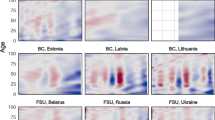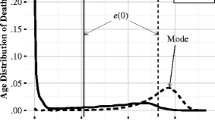Abstract
This paper contributes to the current discussion on longevity by investigating the long-term dynamics of life expectancy, and lifespan variation. The analysis provides the expectiles of the life expectancy distribution, relating them to the values of lifespan variation measured by Keyfitz’s index. This allows us to study both the location and the spread of the life expectancy over time in light of the mortality compression process. Using cointegration analysis, we also explore the long-term dynamics between the two longevity measures in some selected developed countries. Overall, we found evidence of a negative relationship between longevity and lifespan variation, thus confirming previous studies. While, by detecting untracked behaviors taking into account the country-specific contribution over time, this study suggests that the strength of this relationship varies across life expectancy distribution’ sections in which the country is located (i.e. specifically expectile), and how fast the country converges towards best performances.


Similar content being viewed by others
Notes
Expectiles may be considered more difficult to interpret than quantiles, lacking an intuitive interpretation (Newey and Powell 1987; Waltrup et al. 2015). Nevertheless, Jones (1994) considers expectiles as quantiles by a transformation of the original distribution. While, ”quantile regression can be considered as a generalization of median regression, as in the same way expectile regression is a quantile-like generalization of standard mean regression” (Alfó et al. 2016).
References
Aburto JM, van Raalte A (2018) Lifespan dispersion in times of life expectancy fluctuation: the case of central and eastern Europe. Demography 55:2071–2096
Aburto JM, Villavicencio F, Basellini U, Kjærgaard S, Vaupel JW (2020) Dynamics of life expectancy and life span equality. PNAS 117(10):5250–5259
Alfò M, Salvati N, Ranallli MG (2017) Finite mixtures of quantile and M-quantile regression models. Stat Comput 27:547–570. https://doi.org/10.1007/s11222-016-9638-1
Arnold-Gaille S, Sherris M (2016) International cause-specific mortality rates: new insights from a cointegration analysis. ASTIN Bull 46(1):9–38
Barbi E, Camarda CG (2011) Period and cohort effects on elderly mortality: a new relational model for smoothing mortality surfaces. Statistica 71(1):51–69
Boonen TJ, Li H (2017) Modeling and forecasting mortality with economic growth: a multipopulation approach. Demography 54:1921–1946
Bozzo G, Levantesi S, Menzietti M (2020) Longevity risk and economic growth in sub-populations: evidence from Italy. Decis Econ Finance. https://doi.org/10.1007/s10203-020-00275-x
Cheung SLK, Robine JM (2007) Increase in common longevity and the compression of mortality: The case of Japan. Popul Stud 61(1):85–97 (JSTOR)
Colchero F, Rau R, Jones OR et al (2016) The emergence of longevous populations. Proc National Acad Sci (PNAS) 113(48):E7681–E7690
Crimmins E, Kim JK, Vasunilashorn S (2010) Biodemography: new approaches to understanding trends and differences in population health and mortality. Demography 47(Suppl 1):S41
Drefahl S, Ahlbom A, Modig K (2014) Losing ground - Swedish life expectancy in a comparative perspective. PLOS ONE 9(2):e88357. https://doi.org/10.1371/journal.pone.0088357
Edwards RD, Tuljapurkar S (2005) Inequality in life spans and a new perspective on mortality convergence across industrialized countries. Popul Develop Rev 31(4):645–674
Eilers PHC, Marx BD (1996) Flexible smoothing with B-splines and penalties. Stat Sci
Engle RF, Granger CWJ (1991) Long run economic relationships: readings in cointegration. Oxford University Press, Oxford
Grigoriev P, Meslé F, Shkolnikov VM, Andreev E, Fihel A, Pechholdova M, Vallin J (2014) The recent mortality decline in Russia: beginning of the cardiovascular revolution? Popul Develop Rev 40:107–129
Haberman S, Khalaf-Allah M, Verrall R (2011) Entropy, longevity and the cost of annuities. Insur Math Econ 48(2):197–204
Human Mortality Database (HMD) University of California, Berkeley (USA) and Max Planck Institute for Demographic Research (Germany). (www.mortality.org)
Jarner SF, Jallbjorn S (2020) Pitfalls and merits of cointegration-based mortality models. Insur Math Econ 90:80–93
Kannisto V (2000) Measuring the compression of mortality. Demogr Res 3:6. https://doi.org/10.4054/DemRes.2000.3.6
Keyfitz N (1985) Applied mathematical demography, 2nd edn. Springer-Verlag, New York
Koenker R, Bassett G Jr (1978) Regression quantiles. Econometrica 46(1):33–50
Jones MC (1994) Expectiles and M-quantiles are quantiles. Stat Probab Lett 20(2):149–153
Mehta NK, Abrams LR, Myrskylä M (2020) US life expectancy stalls due to cardiovascular disease, not drug deaths. Proc National Acad Sci 117(13):6998–7000
Nemeth L (2017) Life expectancy versus lifespan inequality: a smudge or a clear relationship? PLoS ONE 12(9):e0185702
Newey W, Powell J (1987) Asymmetric least squares estimation and testing. Econometrica 55(4):819–847
Nigri A, Levantesi S, Marino M (2020) Life expectancy and lifespan disparity forecasting: a long short-term memory approach. Scand Actuarial J. https://doi.org/10.1080/03461238.2020.1814855
Oeppen J, Vaupel JW (2002) Broken limits to life expectancy. Science 296(5570):1029–1031
Oeppen J (2006) Life expectancy convergence among nations since 1820: Separating the effects of technology and income. In: Bengtsson T, Keilman N (eds) Old and new perspectives on mortality forecasting. Demographic research monographs (A series of the Max Planck Institute for demographic research). Springer, Cham, pp 197–219
Phillips PCB, Perron P (1988) Testing for unit roots in time series regression. Biometrika 75:335–346
Preston SH (1974) Evaluation of postwar mortality projections in the United States, Canada, Australia, New Zealand. World Health Stat Rep 27(1):719–745
Rau R, Soroko E, Jasilionis D, Vaupel JW (2008) Continued reductions in mortality at advanced ages. Popul Develop Rev 34:747–768
Schnabel SK, Eilers PHC (2009a) Optimal expectile smoothing. Comput Stat Data Anal 53:4168–4177
Schnabel SK, Eilers PHC (2009b) An analysis of life expectancy and economic production using expectile frontier zones. Demogr Res 21(article 5):109–134
Shkolnikov V, McKee M, Leon DA (2001) Changes in life expectancy in Russia in the mid-1990s. Lancet 357:917–921
Shkolnikov VM, Andreev EM, Tursun-zade R, Leon D (2019) Patterns in the relationship between life expectancy and gross domestic product in Russia in 2005–15: a cross-sectional analysis. The Lancet Public Health 4(4):181–188
Vallin J, Meslé F (2009) The segmented trend line of highest life expectancies. Popul Develop Rev 35(1):159–187
Vaupel JW (1997) The remarkable improvements in survival at older ages. Philos Trans Royal Soc London Ser B Biol Sci 352:1799–1804
Vaupel JW, Zhang Z, van Raalte A (2011) Life expectancy and disparity: an international comparison of life table data. BMJ Open 1(1)
Waltrup LS, Sobotka F, Kneib T, Kauermann G (2015) Expectile and quantile regression - David and Goliath? Stat Model 15:433–456
Wilmoth JR, Horiuchi S (1999) Rectangularization revisited: variability of age at death within human populations. Demography 36(4):475–495
Author information
Authors and Affiliations
Corresponding author
Additional information
Publisher's Note
Springer Nature remains neutral with regard to jurisdictional claims in published maps and institutional affiliations.
Appendix
Appendix
According to Newey and Powell (1987), the expectiles of a distribution can be theoretically determined. We denote \(e_p\) the theoretical expectile as a function of an asymmetry parameter p with \(p\in (0,1)\). Therefore, we can calculate a set of expectiles by varying the asymmetry in the interval (0,1). Given a probability density function f(x), with distribution function F(x) and partial moment function G(x), respectively denoted by:
The theoretical expectile \(e_p\) can be found minimizing the following expression (for continuous distributions).
As previously described, expectile regression works similarly to the quantile regression but uses the LAWS model. In fact, the theoretical quantile \(q_p\) can be found minimizing the following expression (for continuous distributions):
The main difference between the above expression and Eq. 8 lies in the definition of the errors considered in the objective function: L2 norm for expectile versus L1 norm for quantile regression. After some algebra and using Eqs. 6 and 7 in the previous equation, we obtain the following solution:
Where m is the mean of the distribution function F(x) and it is equal to \(G(\infty )\). Solving the previous equation for p we obtain the following expression:
After inversion, Eq. 10 allows to obtain the theoretical expectile \(e_p\) for a given p.
Schnabel and Eilers (2009a) suggest to compare sample and theoretical distribution through the expectile-expectile plot (E-E plot), similarly to the well-known Q-Q plot, for a number of values of the asymmetry parameter p.
Rights and permissions
About this article
Cite this article
Nigri, A., Barbi, E. & Levantesi, S. The relationship between longevity and lifespan variation. Stat Methods Appl 31, 481–493 (2022). https://doi.org/10.1007/s10260-021-00584-4
Accepted:
Published:
Issue Date:
DOI: https://doi.org/10.1007/s10260-021-00584-4




